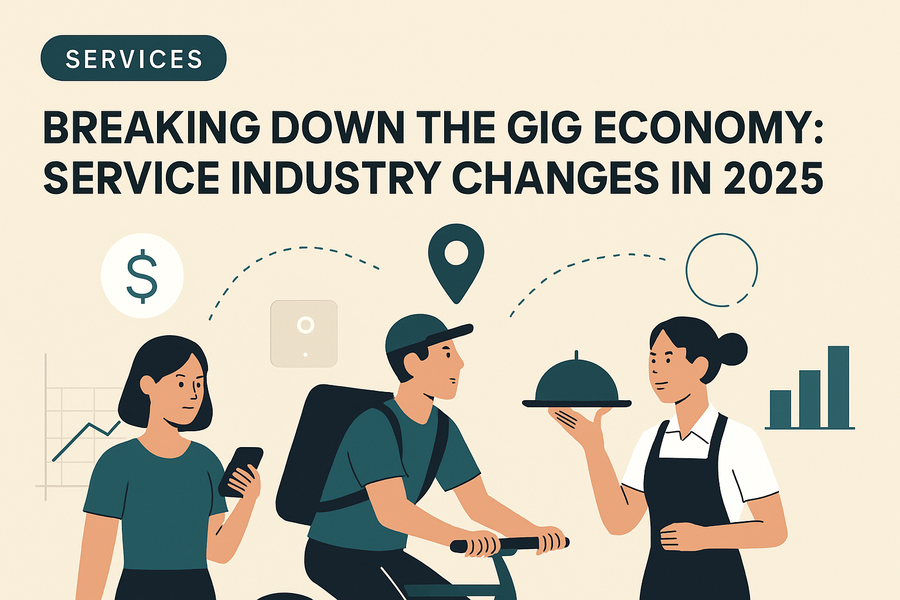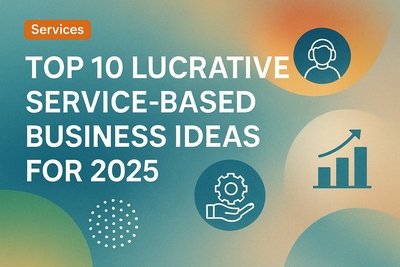
Introduction
In 2025, the gig economy has firmly established itself as a defining force in the global labor market, particularly within the service industry. What began over a decade ago as an experimental labor model driven by ride-sharing and meal delivery apps has now evolved into a sophisticated ecosystem encompassing freelance professionals, remote service providers, and tech-enhanced platforms that connect supply and demand in real-time. The service sector—ranging from hospitality and healthcare to IT support and tutoring—is experiencing dynamic shifts as businesses and workers alike adapt to on-demand models, algorithmic management, and new legal frameworks. In this post, we’ll explore the major changes fueling this transformation, the pros and cons for service workers, and what lies ahead as the gig economy continues to mature.
The Rise of Platform-Centric Work Models
The linchpin of the modern gig economy is the digital platform. Companies like Uber, DoorDash, Upwork, and TaskRabbit have become household names, but in 2025, newer niche platforms are emerging to cater to specialized services such as personal fitness coaching, virtual interior design, and even elder care. These platforms use algorithms to match clients with freelancers based on availability, ratings, and skills.
While this offers consumers convenience and variety, it also creates intense competition among gig workers. A graphic designer on Fiverr, for instance, must now differentiate themselves not just through quality work, but also by mastering SEO-like techniques to boost their visibility within the platform’s search algorithm.
Flexibility vs. Stability: The Worker’s Dilemma
Flexibility remains one of the gig economy’s most appealing traits. Workers can choose when to log on, which jobs to accept, and often where to work from. This autonomy is particularly valuable for caregivers, students, and those seeking supplemental income. In 2025, more than 40% of service-sector workers partake in gig work either full-time or as a side hustle.
However, this flexibility comes at a cost. Without traditional benefits like health insurance, paid leave, or retirement contributions, many gig workers face financial insecurity. Some platforms have introduced opt-in benefit packages or partnered with fintech companies to offer short-term savings plans and microloans, but these solutions are far from universal.
Regulatory Shifts and Legal Recognition
In recent years, governments around the world have grappled with how to classify gig workers. Are they independent contractors, employees, or something in between? In 2025, several jurisdictions have enacted hybrid employment classifications. For example, California’s “FlexWorker” status grants certain benefits like minimum wage guarantees and sick leave without fully classifying workers as employees.
Meanwhile, the European Union has drafted uniform guidelines requiring transparency in algorithmic decision-making, giving gig workers the right to contest low ratings or job denial. These changes reflect growing recognition of the power imbalance between platforms and workers, aiming to create more equitable working conditions.
Technology’s Expanding Role
Automation and artificial intelligence (AI) are deeply embedded in today’s gig economy. Smart scheduling tools, predictive analytics, and machine learning enhance customer matching and streamline operations. For gig workers, this technology can be both a boon and a burden. Automated systems may assign tasks more efficiently, but they also reduce human oversight, potentially perpetuating bias or misunderstandings without recourse.
On the flip side, workers are leveraging technology to their advantage. Mobile apps help track earnings across platforms, optimize gig schedules, and provide tax assistance. Additionally, online communities and forums empower gig workers to share insights, rate clients, and advocate for fair practices.
New Niches and Skill Demands
The gig economy is no longer limited to low-skill or entry-level tasks. In 2025, high-skill gigs are booming. Professionals in fields like UX design, cybersecurity, and digital marketing are increasingly working on a contract basis, lured by lucrative pay and project variety. Even traditionally in-person services like therapy and education are moving online, opening up new avenues for remote gig opportunities.
As a result, skill development is crucial. Workers are investing in micro-credentials, online courses, and certifications to stay competitive. Some platforms now offer built-in skill assessments and training programs, gamifying professional development to retain top talent.
Challenges Facing Businesses
Employers in the service industry also face challenges in adapting to the gig model. While tapping into a flexible workforce reduces overhead costs, it complicates quality control and employee engagement. Retaining reliable gig workers requires thoughtful strategies, from performance incentives to providing tools that aid productivity.
Additionally, companies must navigate legal liabilities and ensure compliance with evolving labor laws. Failing to do so could lead to reputational damage or costly lawsuits. As such, many businesses are creating hybrid teams that combine full-time staff with gig workers, striking a balance between flexibility and accountability.
Consumer Expectations Are Evolving
Consumers in 2025 expect instant gratification and personalized service. The gig economy supports this by enabling 24/7 access to services, but it also raises questions about consistency and trust. Reviews and ratings have become essential to maintaining service quality, making reputation management a critical component for both platforms and individual workers.
Moreover, ethical considerations are entering the consumer consciousness. Many people now prefer to engage with platforms that treat workers fairly, offer transparent pricing, and uphold data privacy standards. As a result, socially responsible gig businesses are gaining a competitive edge.
Looking Ahead: What's Next?
The service industry in 2025 is a reflection of broader economic, technological, and cultural shifts. The gig economy is here to stay, but its long-term sustainability depends on finding equilibrium between flexibility and fairness. Expect more innovations in platform governance, AI accountability, and portable benefits to emerge in the coming years.
As both opportunities and challenges multiply, one thing is clear: the gig economy will continue to reshape how work is defined, valued, and conducted in the service sector.
Conclusion
The gig economy’s impact on the service industry in 2025 is profound, multifaceted, and still unfolding. While it offers unprecedented freedom and opportunity, it also demands new approaches to worker protection, business strategy, and technological integration. Whether you’re a gig worker, a business owner, or a consumer, understanding these changes is key to navigating the modern marketplace. By staying informed and adaptable, stakeholders at every level can help shape a more resilient and inclusive gig-driven future.







